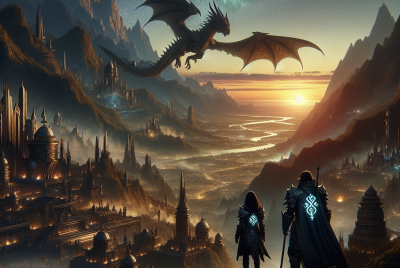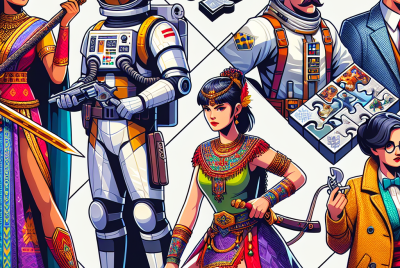A Blast from the Past: 90s Video Games That Shaped the Future
Iconic Consoles of the 90s
The 1990s witnessed a revolution in video gaming, with powerful consoles and innovative gameplay experiences that set the stage for the future of the industry. Key players included the Super Nintendo Entertainment System (SNES), Sega Genesis, and the PlayStation. Each of these systems hosted groundbreaking titles that remain influential today.
Super Nintendo Entertainment System (SNES)
The SNES, launched in North America in 1991, introduced gamers to rich graphics and engaging gameplay. Iconic titles like “Super Mario World,” “The Legend of Zelda: A Link to the Past,” and “Street Fighter II” redefined platform gameplay and storytelling in video games. SNES’s 16-bit graphics allowed developers to create vibrant worlds filled with complex characters and rich narratives, influencing future RPGs and platformers.
Sega Genesis
Competing directly with the SNES, the Sega Genesis offered gamers an edgy experience with titles like “Sonic the Hedgehog,” which pushed the boundaries of speed and platforming. The game’s bright graphics and catchy music made it hugely popular, leading to a franchise that remains relevant. The Genesis also introduced the concept of sports games with “Madden NFL,” which laid the foundation for sports simulators in the years to come.
PlayStation
Debuting in 1994, the Sony PlayStation revolutionized the gaming landscape by introducing CD-ROM technology, significantly increasing storage capacity for games. Titles like “Final Fantasy VII,” “Metal Gear Solid,” and “Resident Evil” showcased 3D graphics, intricate storytelling, and immersive gameplay, creating a benchmark for future titles. This console expanded the gaming demographic, attracting an older audience that appreciated narrative depth and complex gameplay mechanics.
Genre-Bending Titles
The 90s also saw the emergence of genres that would shape gaming in subsequent years.
Role-Playing Games (RPGs)
The RPG genre truly exploded in the 90s, with titles like “Final Fantasy VII,” “Chrono Trigger,” and “EarthBound” offering deep storylines and character development. These games pioneered turn-based combat mechanics that influenced countless future RPGs. “Final Fantasy VII,” in particular, was significant for its cinematic presentation and emotional storytelling, setting a new standard for narrative-driven games.
First-Person Shooters (FPS)
“Doom,” released in 1993, redefined the first-person shooter genre with its fast-paced action and immersive gameplay. “Duke Nukem 3D” and “Quake” followed, bringing 3D graphics and multiplayer capabilities that expanded the gaming experience beyond single-player narratives. The popularity of FPSs paved the way for franchises like “Call of Duty” and “Halo,” which continue to dominate the gaming industry.
Fighting Games
The 90s were the golden age for fighting games. Titles such as “Street Fighter II” and “Mortal Kombat” not only popularized competitive gaming but also laid the groundwork for esports. The introduction of combo mechanics and character specials created a competitive landscape that remains highly relevant in today’s gaming culture.
Innovative Gaming Mechanics
The era also pioneered innovative gaming mechanics that shaped how games are played.
3D Graphics and Open Worlds
The shift from 2D to 3D graphics was a monumental leap. “Super Mario 64” revolutionized platform gaming with its open-world exploration and 3D mechanics, allowing players to engage in a fully realized 3D universe. This concept of open-world gameplay has influenced modern titles like “The Legend of Zelda: Breath of the Wild,” offering players unparalleled freedom in exploring vast game worlds.
Save Systems and Checkpoints
Before the 90s, most games required players to start over after a game over. However, the introduction of save systems and checkpoints in games like “The Legend of Zelda: Ocarina of Time” drastically changed gameplay. Players could now save their progress, making longer and more complex games feasible. This hallmark became an industry standard, leading to customized gaming experiences.
The Rise of Multiplayer Gaming
The 90s also saw a significant shift toward multiplayer gaming, both in local and online formats.
LAN Parties and Multiplayer Consoles
Games like “GoldenEye 007” on the Nintendo 64 and “Doom” on PC set the stage for multiplayer gaming experiences. Friends gathered in living rooms or at LAN parties, sharing experiences that unified gamers. This laid the groundwork for future online gaming communities, establishing competitive aspects in gaming as a popular social experience.
The Internet Revolution
As the internet gained prominence, games such as “Quake” and “StarCraft” allowed players to compete worldwide. This marked the dawn of online multiplayer gaming, cultivating a competitive scene that would later evolve into the esports industry. The online connectivity changes in gaming culture have redefined how players interact, compete, and form communities.
The Impact of Game Design and Storytelling
The intricate storytelling and game design in the 90s laid the groundwork for contemporary storytelling in video games.
Narrative Depth
Games like “Final Fantasy VII” and “The Legend of Zelda: Ocarina of Time” have set new standards for narrative complexity in games. Players were no longer just jumping on platforms or shooting enemies; they were immersed in compelling tales that engaged them emotionally. This evolution has influenced mainstream gaming to focus on rich narratives, character arcs, and innovative story structures.
Artistic Beginnings
90s video games embraced a distinctive artistic style, with pixel art and hand-drawn animations in games like “Castlevania: Symphony of the Night.” This artistic flair paved the way for future indie games that prioritize unique aesthetics and storytelling over photorealism and large budgets.
Legacy and Continued Influence
The legacy of 90s video games is visible in the current gaming landscape. Many titles from that era have been remade or reimagined for modern consoles, highlighting their timeless appeal. Games are now more technologically advanced but continue to draw inspiration from the mechanics, storytelling techniques, and artistry established in the 90s.
Remakes and Reboots
The continuation of franchises like “Final Fantasy” and “Resident Evil” through remakes has breath new life into classic games. They not only appeal to nostalgic fans but also introduce these pioneering gaming experiences to newer generations, reaffirming their relevance.
Indie Game Movement
The indie game movement bears deep similarity to the creativity and risk-taking seen in the 90s, encouraging fresh ideas in gameplay and design. Titles such as “Celeste” and “Hollow Knight” echo the charm of past games while incorporating modern gaming sensibilities. This new wave of developers is continuously reshaping the industry, much like their 90s predecessors.
Esports and Competitive Gaming
The competitive gaming landscape owes its existence to the multiplayer gaming environment of the 90s. Genre delineations have blurred, creating cross-genre titles that resonate with competitive players and drive a community-oriented atmosphere. Titles like “Counter-Strike” and “League of Legends” stem from the foundations laid during this pivotal decade.
The Retail Evolution
The retail landscape of video gaming changed significantly in the 90s with the emergence of prominent gaming chains and online sales.
Specialty Retailers
The rise of stores like Electronics Boutique and GameStop catered directly to gamers, making purchases accessible and fostering communities around game releases. This model of organized retail remains influential, shaping how games are marketed and sold.
Digital Distribution
With the internet’s integration, platforms like Steam emerged, shifting the purchasing paradigm away from physical copies to digital downloads. This evolution began in part with 90s online games and has transformed how gamers receive and experience new titles.
Final Thoughts
The innovations and processes that emerged from the 90s continue to shape the future of gaming. From core mechanics and storytelling advancements to the cultural implications, the decade set the trajectory for video game development for years to come. Each title and console laid vital groundwork for the dynamic, immersive, and community-driven gaming experience we cherish today.




